De Havilland Sea Venom
FAA models in 1/72 scale kit review and modelling report
De Havilland Sea Venom , carrier based fighter-bomber.
This kit is from Toko (similar, seems to be ex-Frog and re-boxed with new decals sheet)
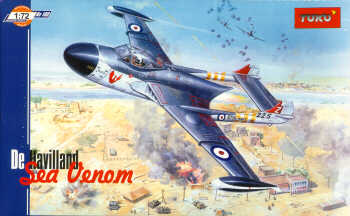
Brief history
The Venom was developed by De Havilland Aircraft from their earlier Vampire, which had been the second type of jet fighter to enter service with the RAF. In need for a fighter of higher performance de Havilland's responded with the Venom. The Sea Venom was the naval version of the RAF's Venom fighter-bomber.
The Sea Venom
was developed for naval service as the FAW.20 and 21, being based on the
two seat NF.2. It had folding wings and a strengthened fuselage with
arrester gear. The Sea Venom was in service from 1954 to 1960 and was the
Navy's first all-weather jet fighter.
Large numbers
of Venom night fighters and Sea Venoms (about 400) were built at the De
Havilland factory in the mid 1950’s. Royal Navy Sea Venom's and RAF Venom
FB.4's took part in the Suez Operation of November 1956, attacking Egyptian
airfields and convoys. The box top of the TOKO kit shows this. The Sea
Venom remained in service with the Royal Navy until replaced by the de
Havilland Sea Vixen in the early 1960's.
Some technical
data Sea Venom:
Wing span
12.71 m
Service ceiling
48,000 ft
Length
10.10 m
Max speed
920 km/hr
Engine:
DH Ghost 48
More info here:
http://www.neam.co.uk/venom.html
![]()
The TOKO
kit
The kit has about 50 parts, many
of them needing clean up as the moulds originate from FROG. The decals are
very good with some colour schemes to be chosen.

The canopy of TOKO is very thick,
so I got a vacuformed thin replacement canopy from AeroClub.

There is no real interior in this
kit so with some plastic card and rod an interior was made. I also cut off the
tip tank fins as they are much too thick.
Please note
that the root intakes need special attention, see drawing of the root
intake above. I inserted
air flow guiding vanes toward the engine front using thin plastic card.
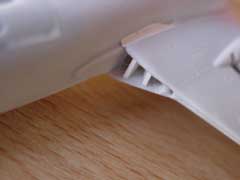
please note
that cockpit detailing will be at a later stage.
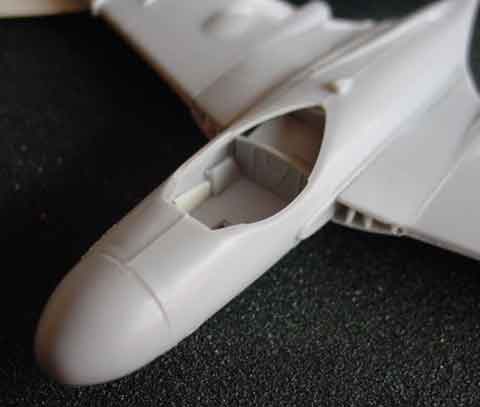
Alignment of the tail booms requires
care, take slow drying glue and align. Let dry at least 24 hrs.

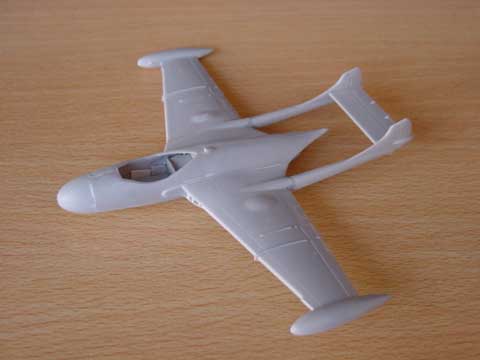
Some sanding and filling is needed
at their connection points. The nose needs some weight to prevent "tail
sitting". After major assembly, I re scribed some panel lines using an
OLFA P-cutter as these are not engraved and after that sanded the model
smooth.

I also sawed in the flaps and ailerons to get a good look. Also, replace the very thick
gear doors with some card plastic.
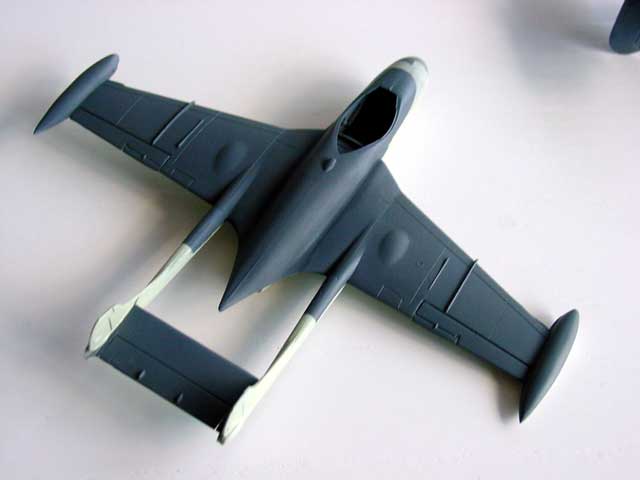
The kit got a light grey coat to check any flaws and after correction, the colour coats of Sky and Dark sea Grey were applied.

The lower details of the kit, with new gear doors from card. Aft of the cockpit seats, an avionics compartment was made with boxes as seen in many photos. The seats came as per kit , but with extra details made from some card and stretched sprue. Further cockpit finishing will be done after painting with straps etc. Instrument panels were made using home made decals.
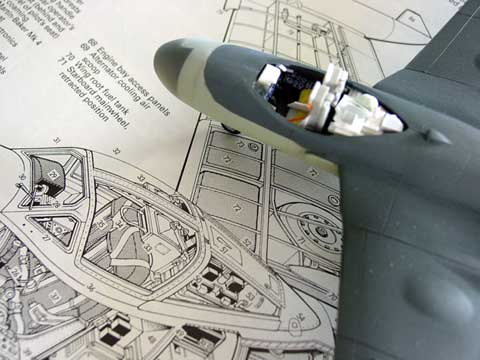
The Air International Vol. 39 no 2 of August 1990 acted as a reference.
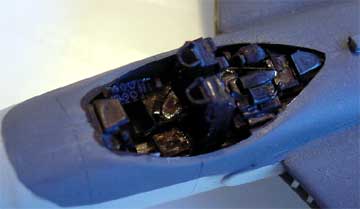
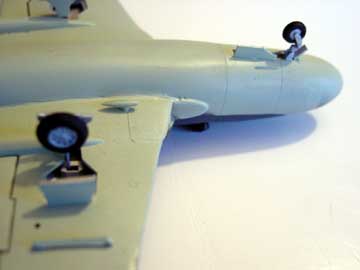
The landing gear, new wheels came
from the spare box. The kit parts are rather crude.
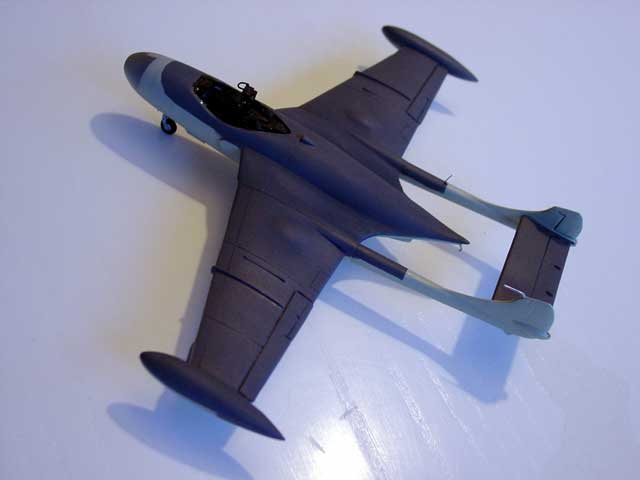
On the tip tanks, a small fin was added from card. A pitot was added on the left vertical tail leading edge. (Note: only the prototypes to my knowledge had the balans masses on the stabilizer, so these were not added).
The canopy was also to be installed later on (from Aeroclub).
The markings have a scarlet (deep red) tail panel and black tip tanks with a white lining. On the boxtop, the aircraft is seen with "Suez" invasion stripes; as these are not provided as decals and I could not find any pictures of this particular finish, I used the scheme and decals as suggested by TOKO.
The Sea Venom model was similarly finished as the other FAA models, and the model was decalled after it got a gloss coat of Johnson Clear varnish. I used also DACO decal setting fluid to get the decals conforming to the underlying surface.
After ample decals drying time, the model got another coat of matt Johnson Future, realized by mixing into the varnish some Tamiya X21 "flat base" agent. A semi matt end effect was achieved.

The tip tanks were opainted with a
paint brush, the white striping also applied with a brush. The canopy with
set open with its framing also painted. A small windscreen wiper was added
from sprue.
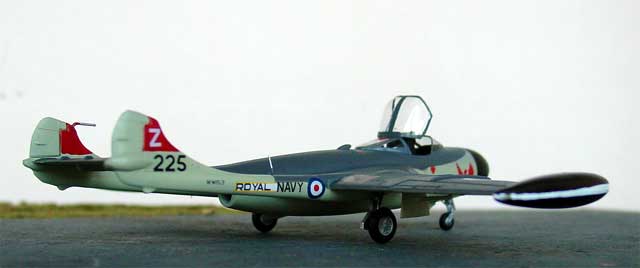
I had some trouble with the red stripings
silvering, so apply amply og gloss coat first and DACO decals setting agent.
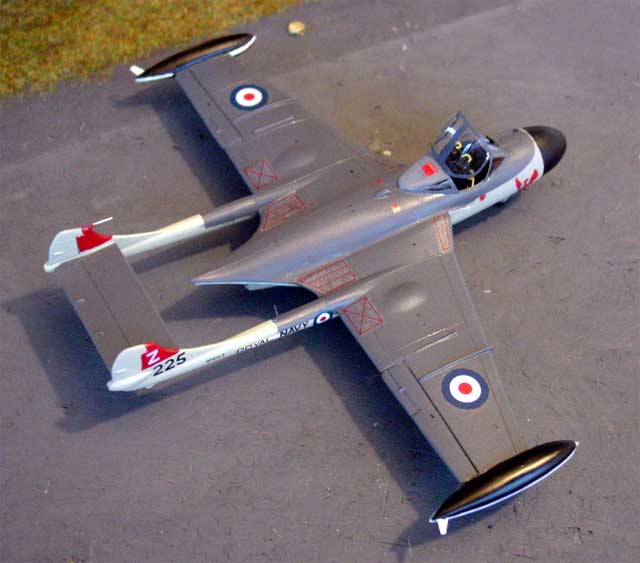
The cockpit hood was finally attached and I still wonder how pilots got into this plane! It must have been a very crampted and hilarious excersice to get in.
And there she is... a nice little
Sea Venom !
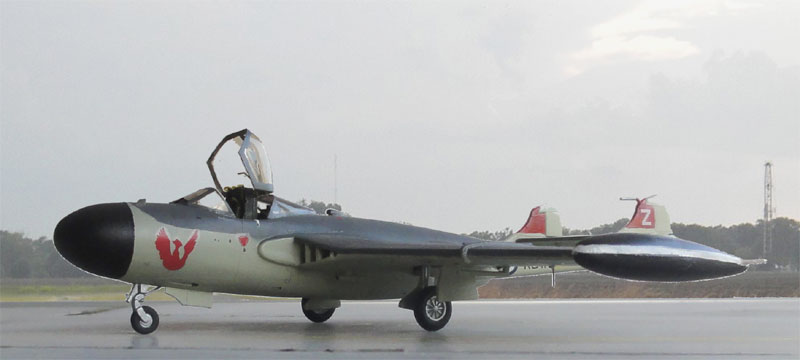
Back to FAA page
Back to 1/72 Models.......

(c) Copyright Meindert "designer"/ All rights reserved. Your comments are welcomed by webmaster
Created this page January 17, 2005